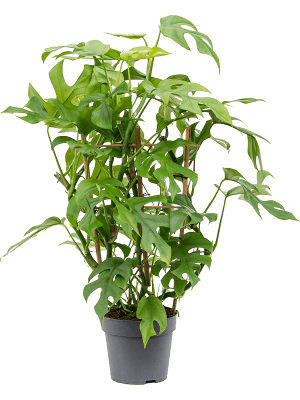
Monstera minima
Rack
4MOMIBU17
Thanks to its unusual leaves full of holes, the Monstera is a trendy plant that is also very easy to look after. Our range includes various types and sizes of this popular Swiss cheese plant. Would you like to know more about the different varieties and how to look after them? Then read on.
The Monstera is a creeping climbing plant that is native to the tropical rainforests from southern Mexico to Panama. The plant has a thick stem and large, glossy leaves. The leaves are distinctive because of their splits and the holes that develop in them. Because this is so unusual, the plant has been named ‘Monstera’, which means ‘abnormal’ in Latin. These holes and splits not only give the plant beauty, they are also very practical. They prevent the plant from being blown over in a storm because the wind and rain mostly pass through the splits.
The Monstera deliciosa is a creeping climber with aerial roots. The plant has a thick stem and large, shiny leaves. Typical of this characteristic leaf are the incisions and holes that appear in them. The large leaves are shiny green and like a place in light shade. In the tropical rainforests where this member of the Arum family grows, it can reach 20 metres in height or length. As the plant ages, more and more holes appear in its leaves and its shape becomes more and more beautiful. A Swiss cheese plant grows in the wilderness around the trunk of another tree. A moss stick simulates the trunk and guides the plant upwards. When the Monstera is a few years old, all kinds of branches appear. These are aerial roots that look for a place to attach themselves. Tie them to the stick and the plant will grow beautifully in height. This way you can keep the plant in good shape. Tip: Keep the moss stick moist so the roots can attach themselves better. Long shoots, unsightly leaves or old stems can be cut off at the sprouting point with a pair of secateurs.

Choose the Monstera obliqua, or Monstera monkey mask, if you are looking for a striking green hanging plant. This special plant originates from Mexico and is currently very popular because of its special leaves with holes. Monstera obliqua is easy to care for and prefers a light location, but does not like direct sunlight. The Monstera will also do well in a darker room, but the plant will grow a little less quickly.

The Monstera Minima looks like the deliciosa but has a smaller leaf. Originally, this plant comes from South Asia. There, the plant can grow up to 6 metres long. The Monstera Minima owes its name to the similarities, but officially the botanical name is Rhapidophora tetrasperma. There is also a clear difference in the manner of growth. With Monstera, the notches and holes in the leaf appear after it has been rolled out. In Rhapidophora the holes with the characteristic notches are already in the young leaf.
